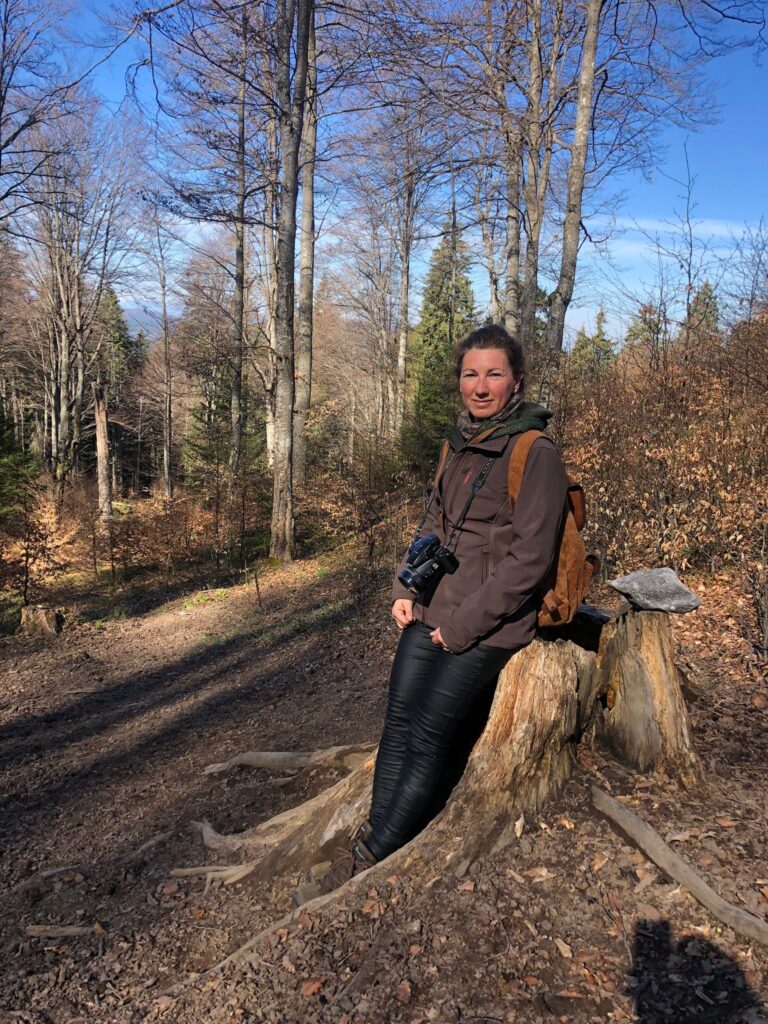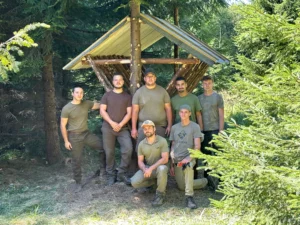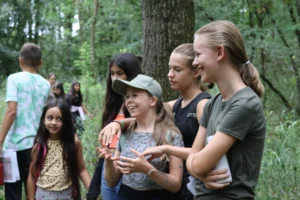In our previous post we shared the experiences of the first few days of the spring internship organised by our Foundation, and now the student participant of the internship tells us about her adventures in Transylvania.
Ms Diána Mészáros Gazsó practical diary Part II
On Friday, I was exceptionally assigned to another hunter (Boti), with whom we left early in the morning to fill the salt pans in the area. We walked quietly in the woods in case we "saw something". So they say. We made our way up a steep climb to the salt pans, where I finally got to experience what it was like to walk through a plethora of spruce. Unfortunately, there is a lot of logging in the area, and areas untouched by forestry work are very rare. We did manage to see some deer and a roe buck. On the way, I learned a very useful Szekler saying, which has become a personal favourite of mine:
"For every why there is a why."

In the valley, just as we were about to reach the car, I saw the remains of a wild skull. It turned out to be the owner of a wild boar, but its tusks were missing. We speculated as to what had happened to it, possibly African swine fever...but then where had the tusks gone?...
The cold wind blew through, the creek tops were covered with thin ice, and it was nice to have a nice hot tea and a delicious breakfast in the hunting lodge. In the early afternoon we laid a blood trap for Attila's bloodhound, Tapi. While the trail "cooled", we drove to more and more remote places with the small Polaris loaded with corn. We also made it to the farthest point in the area, Manichka, which I learned is one of the best deer-baiting spots in the fall. We set out corn on the spreader there. Then we went back to the worked out trail and Attila dropped the bloodworm on the trail, which took about 2 hours. Tapi did a perfect job.
The evening programme is the usual ambush, watching the spreader to "see what comes in". We planned to sit out on the "Four" ambush, which for me, a girl from the lowlands, was the net worst of my fears. The switchback favoured by the bears is the same as the trail back and forth to the ambush. In addition, we put corn on the spreader about an hour before we entered the den, when a big brown bear was already munching away. Of course, after some hesitation, it ran away. As we were leaving the spreader, another large bear was heading in the direction we came from. There was evening excitement in full force as we went back to take our places in the read. Much to our surprise, however, none of the bears came back, except for one smaller bodied one. It's no easy feat to spot a bear!
Saturday was a day of rest. The sun finally came out, so the well-kept garden of the hunting lodge was the perfect place for a sunbath. I ate and drank well, recharged after a long week. I looked forward to Sunday to see what adventures awaited me again.
On Sunday morning, the team gathered, the plan was to finish the high pass that had been started earlier. The weather had promised to be nice, so we loaded the kettle into the car to make some paprika fries (dandelion sturgeon). Well, there was a special person assigned to this task, my main job was to paint the les. Just as Attila was putting the slats up the side of the stall, I was painting the outside of the stall. Meanwhile, the other two boys were putting the ladders together for the structure. The potatoes with paprika, cooked in the kettle, were also being prepared, and the hungry party had a good bite. Especially me, as the "colleagues" did not fail to notice. It was a good atmosphere, not to mention. We had made really good time when a huge hailstorm hit us. When it passed, it was not so good to work, because the snow was wet, slippery and the weather was turning cold. We did some unavoidable finishing touches and headed home. In fact, it was getting late in the evening.
On Monday, Attila and I had planned to take salt up to Koszorús mountain as part of a longer hike. We set off in the morning by car, which we had to leave at the foot of the mountain because the water had washed out the road leading up, so the car couldn't go up that big rocky, muddy road. Steep hillsides gave way to gentle slopes and streams accompanied our journey.

The idyllic forest scenery was more and more beautiful. By the time we reached the top of the mountain, we were running out of energy. We rested for a while and took out the delicious French bread from the bag. In that crystal clear air, nothing could have been better. Then came the black soup. As we wanted to reach the deer roaring place planned for September, the only way to get there was through a snowy wilderness. It was unusual to be trampling the snow on the first day of May. But this trip was my favourite of all because I had never seen anything like it. There were times when we were knee deep in snow, but I didn't mind. The sight of huge ancient pines that had never seen an axe, the untouched nature was overwhelming. Attila, of course, was not slow to point out fresh bear tracks, which made me break out in a sweat. I immediately scrambled to my feet. Finally, without encountering a bear, we reached our destination, salting a rotten hole in a tree, and mission accomplished. Up there, above it all, we also rested for a while. We talked about the mountains we had been to, where we had built the tower, and the names of the mountains. Then we headed back to the car. It was another longer ride, but it's always easier going down. We fed the bears in the olive grove and headed home. Back home, Verus was waiting for us with delicious soup and char-grilled munchies and meat. We ate and drank well, reported on what we had seen, and then we all went our separate ways.
On Tuesday we set off with Boti, planning to clear the stalking paths and fill some salt pans. Our first trip was to the Fourth Area, where we climbed a very steep hill to reach the salt logs. All the while we were following a fresh bear bog, which caused a bit of tension in me. We kept our eyes open, walking in silence so as not to disturb the morning peace of the forest. We did manage to catch a scene of four well-muscled young bull moose scrambling up the steep slope. Their antlers are already developing, but you can already see that these are going to be really showy.

Along the way we also analysed tracks and identified droppings, what kind of game, how old the track is, how old the owner of the track might be. This is very useful information for a hunter or game manager. After that we went on to the Barta, where we sprinkled corn on the scattering area, where we expected mainly wild boar in the evenings. We also cleared the stalking paths of fallen leaves and dry branches, which is important to ensure a quiet, unobtrusive approach to the ambush.
The Beautiful Forest was our next stop. The programme was the same, putting out spray feed and clearing the stalking paths.
In the evening we went out to the marsh to sit out the ambush. We were expecting mostly wild boar, but we saw two roe deer, a mother bear with her three-year-old cub and two male bears. After half past 8:30, as it was getting dark, we headed back from the lodge to the car we had left about 200 meters away. For me, this is the equivalent of an annual adrenaline rush every time.
On Wednesday, the plan was again to fill the salt pans, an important task every spring. We also went up to Ölves, where there is a well-constructed medveles made of the only stone. The area around the sprinkler was full of small and large bear dens, promising bear migration in this area. We cleared the scout trail here, as we have done in all the previous dens. We also filled in the salt marsh at Gypsy Creek and the salt marsh at Mohos. Somehow it always happens that wherever our trail leads, there are always fresh bear tracks leading through the forest, which makes the trip to the salt pond even more exciting. We even spotted the tracks of an exceptional wolf.
The hunting company is participating in a national research project to survey the brown bear population. By collecting DNA samples from fresh faeces, the researchers are supporting the project. As soon as fresh bear droppings are found, which must be no older than three days old and must not have been exposed to rain, they are sampled with a stick dipped in a special liquid. An app is used to mark the sampling location and exact coordinates, upload various data to the sample and send it to the centre. The sample itself is then handed in to the County Forestry Office, which forwards it to the relevant department. Boti (Botond Demes) is the person in charge of this matter at the company.
Cover photo by Diána Mészárosné Gazsó





